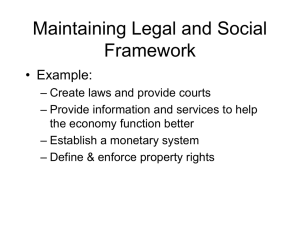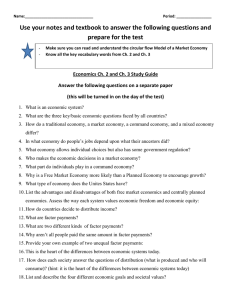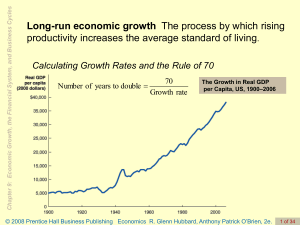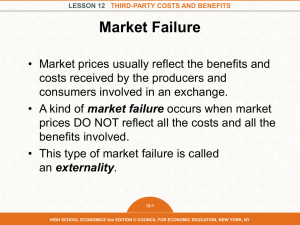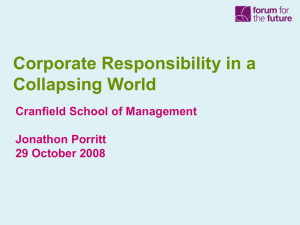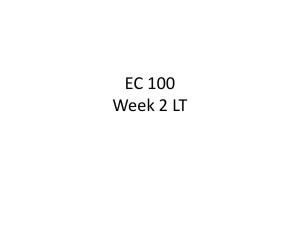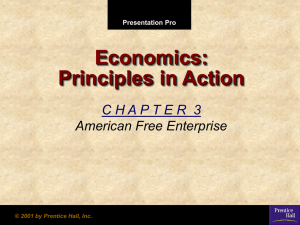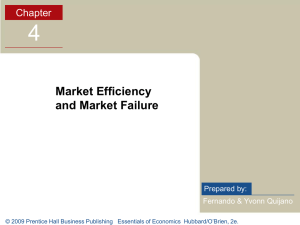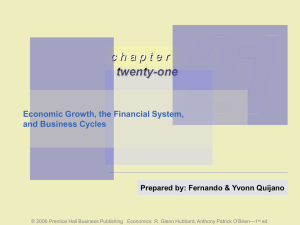Economics, by R. Glenn Hubbard and Anthony Patrick O'Brien
advertisement
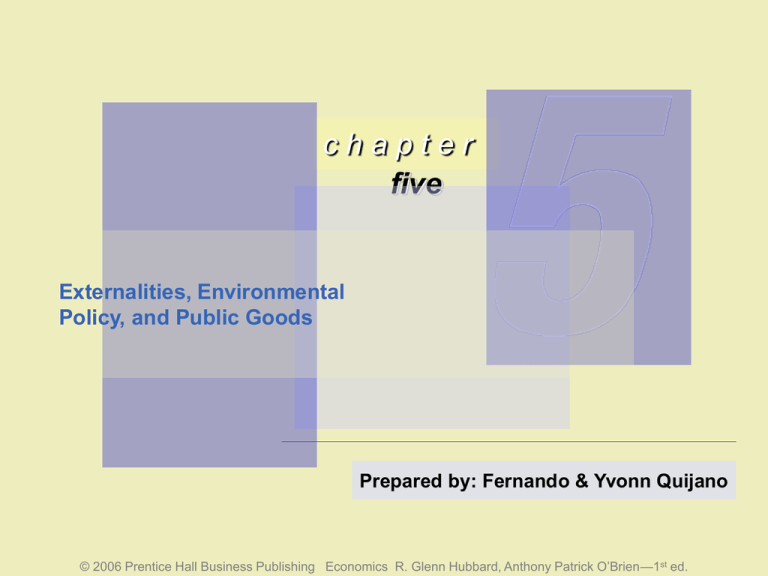
chapter five Externalities, Environmental Policy, and Public Goods Prepared by: Fernando & Yvonn Quijano © 2006 Prentice Hall Business Publishing Economics R. Glenn Hubbard, Anthony Patrick O’Brien—1st ed. 1 LEARNING OBJECTIVE CHAPTER 5: Externalities, Environmental Policy, and Public Goods Externalities and Efficiency Externality A benefit or cost that affects someone who is not directly involved in the production or consumption of a good or service. The Effect of Externalities Private cost The cost borne by the producer of a good or service. Social cost The total cost of producing a good, including both the private cost and any external cost. Private benefit The benefit received by the consumer of a good or service. Social benefit The total benefit from consuming a good, including both the private benefit and any external benefit. © 2006 Prentice Hall Business Publishing Economics R. Glenn Hubbard, Anthony Patrick O’Brien—1st ed. 2 of 27 CHAPTER 5: Externalities, Environmental Policy, and Public Goods Externalities and Efficiency HOW A NEGATIVE EXTERNALITY IN PRODUCTION REDUCES ECONOMIC EFFICIENCY 5-1 The Effect of Pollution on Economic Efficiency © 2006 Prentice Hall Business Publishing Economics R. Glenn Hubbard, Anthony Patrick O’Brien—1st ed. 3 of 27 CHAPTER 5: Externalities, Environmental Policy, and Public Goods Externalities and Efficiency HOW A POSITIVE EXTERNALITY IN CONSUMPTION REDUCES ECONOMIC EFFICIENCY 5-2 The Effect of a Positive Externality on Efficiency © 2006 Prentice Hall Business Publishing Economics R. Glenn Hubbard, Anthony Patrick O’Brien—1st ed. 4 of 27 CHAPTER 5: Externalities, Environmental Policy, and Public Goods Externalities and Efficiency Externalities Can Result in Market Failure Market failure Situations where the market fails to produce the efficient level of output. What Causes Externalities? Property rights The rights individuals or businesses have to the exclusive use of their property, including the right to buy or sell it. © 2006 Prentice Hall Business Publishing Economics R. Glenn Hubbard, Anthony Patrick O’Brien—1st ed. 5 of 27 2 LEARNING OBJECTIVE CHAPTER 5: Externalities, Environmental Policy, and Public Goods Private Solutions to Externalities: The Coase Theorem The Economically Efficient Level of Pollution Reduction 5-3 The Marginal Benefit from Pollution Reduction Should Equal the Marginal Cost © 2006 Prentice Hall Business Publishing Economics R. Glenn Hubbard, Anthony Patrick O’Brien—1st ed. 6 of 27 CHAPTER 5: Externalities, Environmental Policy, and Public Goods Private Solutions to Externalities: The Coase Theorem The Problem of Transactions Costs Transactions costs The costs in time and other resources that parties incur in the process of agreeing to and carrying out an exchange of goods or services. The Coase Theorem Coase theorem The argument of economist Ronald Coase that if transactions costs are low, private bargaining will result in an efficient solution to the problem of externalities. © 2006 Prentice Hall Business Publishing Economics R. Glenn Hubbard, Anthony Patrick O’Brien—1st ed. 7 of 27 CHAPTER 5: Externalities, Environmental Policy, and Public Goods Government Solutions to Externalities Command and Control versus Tradeable Emissions Allowances Command and control approach Government-imposed quantitative limits on the amount of pollution firms are allowed to generate, or government-required installation by firms of specific pollution control devices. © 2006 Prentice Hall Business Publishing Economics R. Glenn Hubbard, Anthony Patrick O’Brien—1st ed. 8 of 27 4 LEARNING OBJECTIVE CHAPTER 5: Externalities, Environmental Policy, and Public Goods Four Categories of Goods Rivalry The situation that occurs when one person’s consuming a unit of a good means no one else can consume it. Excludability The situation in which anyone who does not pay for a good cannot consume it. Private good A good that is both rival and excludable. 5-8 Four Categories of Goods © 2006 Prentice Hall Business Publishing Economics R. Glenn Hubbard, Anthony Patrick O’Brien—1st ed. 9 of 27 CHAPTER 5: Externalities, Environmental Policy, and Public Goods Four Categories of Goods Common resource A good that is rival but not excludable. Public good A good that is both nonrivalrous and nonexcludable. Free riding Benefiting from a good without paying for it. © 2006 Prentice Hall Business Publishing Economics R. Glenn Hubbard, Anthony Patrick O’Brien—1st ed. 10 of 27 CHAPTER 5: Externalities, Environmental Policy, and Public Goods Public Goods and Common Resources Common Resources 5 - 12 Overuse of a Common Resource Tragedy of the commons The tendency for a common resource to be overused. © 2006 Prentice Hall Business Publishing Economics R. Glenn Hubbard, Anthony Patrick O’Brien—1st ed. 11 of 27 CHAPTER 5: Externalities, Environmental Policy, and Public Goods Coase theorem Command and control approach Common resource Excludability Externality Free riding Market failure Pigovian taxes and subsidies Private benefit Private cost Private good Property rights Public good Rivalry Social benefit Social cost Tragedy of the commons Transactions costs © 2006 Prentice Hall Business Publishing Economics R. Glenn Hubbard, Anthony Patrick O’Brien—1st ed. 12 of 27
